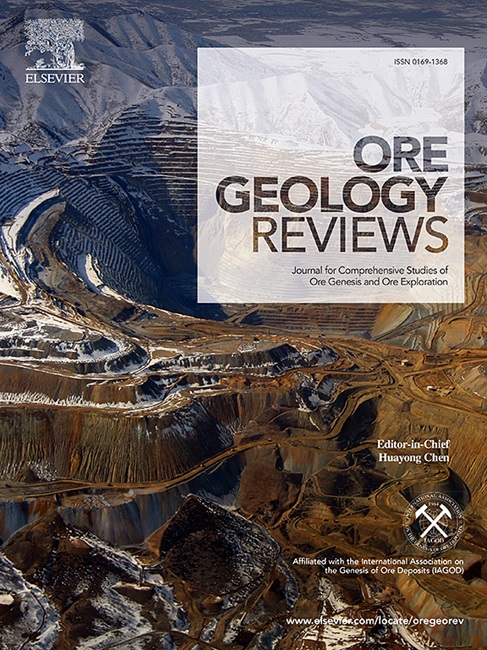华中秦岭北麓姚庄铅锌矿床的地质、流体包裹体和 H-O-S 同位素研究
IF 3.2
2区 地球科学
Q1 GEOLOGY
引用次数: 0
摘要
造山带远端铅锌银脉型矿床与斑岩型钼系统之间的成因关系不明确,尤其是成矿流体来源、金属运移机制和岩浆-热液过程。本研究结合华中秦岭北麓带姚庄铅锌矿床的野外观测、流体包裹体和H-O-S同位素分析,阐明了铅锌矿化与深部斑岩系统之间的成因联系。铅锌矿体赋存于中新生代变质海相火山岩和碎屑岩中。姚庄铅锌矿床的蚀变和矿化可分为以下几类:石英-黄铁矿-黄铜矿阶段(第一阶段)、石英-方解石-多金属硫化物阶段(第二阶段)和方解石-石英阶段(第三阶段)。第一阶段由石英-黄铁矿-砷黄铁矿和石英-黄铁矿矿脉所界定。黄铁矿通常呈近方形至长方形,通常被后来的方铅矿和闪锌矿改变或沿其断裂填充。第二阶段的特点是铅锌矿化显著,黄铁矿、方铅矿、闪锌矿、黄铜矿和黄铁矿等硫化物与石英方解石±黑云母±绢云母共生,一般以脉状出现。该阶段的黄铜矿和黄铁矿在局部地区会以液滴形式出现在闪锌矿中,表明是与铅锌矿化同时形成的。第三阶段的特征是方解石-石英矿脉,这些矿脉通常与之前形成的含硫化物矿脉(第一和第二阶段)交叉,表明它们形成的时间晚于主要成矿阶段(第二阶段)。从第一阶段到第三阶段,可以观察到四种类型的流体包裹体:富含 CH4(LC 型)、水(W 型)、富含 CO2(C 型)和多相含固(S 型)流体包裹体。姚庄不同类型流体包裹体的微测温结果表明,温度和盐度从第一阶段(峰值约为 400-445 °C、7.0-9.0 和 10.5-12.0 wt% NaCl 当量)开始下降,经过第二阶段(峰值约为 265-295 °C、5.0-5.5 wt% NaCl 当量)到第三阶段(峰值约为 145-175 °C、0.5-1.5 wt% NaCl 当量)。第二阶段石英的H-O同位素组成(δDfluid = -96 ‰至-80 ‰,δ18Ofluid = 4.9-5.4‰)表明,该阶段的流体主要来源于岩浆-热液,但也有陨石水注入,导致流体混合。这一推论与流体演化的温度和盐度从第一阶段向第二阶段递减是一致的。第一阶段和第二阶段硫化物的原位硫同位素相当(-3.6 ‰至 6.4 ‰),这也表明主要起源于岩浆-热液。结合最近通过钻芯验证和地球物理勘查等综合调查发现的姚庄地区地下隐伏斑岩型钼相关花岗岩侵入体,我们认为姚庄铅锌矿床是热液脉型矿床,可能与斑岩型钼相关花岗岩侵入体有关。本文章由计算机程序翻译,如有差异,请以英文原文为准。

Geology, fluid inclusions, and H–O–S isotopes of the Yaozhuang Pb–Zn deposit in the Northern Qinling Belt, Central China
The genetic relationship between distal Pb–Zn–Ag vein-type deposits and porphyry molybdenum systems in orogenic belts is ambiguous, especially for ore-forming fluid sources, metal transport mechanisms, and magmatic–hydrothermal process. This study combines field observations, fluid inclusions, and H–O–S isotopic analyses from the Yaozhuang Pb–Zn deposit in the Northern Qinling Belt, Central China, in which a concealed porphyry molybdenum-related granitic intrusion exists, to clarify the genetic link between Pb–Zn mineralization and the deeper porphyry system. The Pb–Zn orebodies are hosted in the Mesoproterozoic metamorphic marine volcanic rocks and clastic rocks. Alteration and mineralization of the Yaozhuang Pb–Zn deposit could be categorized: Quartz–pyrite–arsenopyrite stage (Stage I), quartz–calcite–polymetallic sulfide stage (Stage II), and calcite–quartz stage (Stage III). Stage I is defined by quartz–pyrite–arsenopyrite and quartz–pyrite veins. Pyrite typically exhibits subhedral to euhedral and was commonly altered or filled by later galena and sphalerite along its fractures. Stage II is featured by notable lead and zinc mineralization, with extensive sulfides such as pyrite, galena, sphalerite, chalcopyrite, and pyrrhotite, coexisting with quartz–calcite ± biotite ± sericite and generally occurring as veins. Locally, chalcopyrite and pyrrhotite of this stage can occur as droplets in sphalerite, indicating simultaneous formation with Pb–Zn mineralization. Stage III is characterized by calcite–quartz veins that commonly crosscut previous formed sulfide-bearing veins (Stage I and II), indicating they formed later than the main mineralization stage (Stage II). From Stage I to III, four types of fluid inclusions are observed: CH4-rich (LC-type), aqueous (W-type), CO2-rich (C-type), and multi-phase solid-bearing (S-type) fluid inclusions. The microthermometric result from different types of fluid inclusions at Yaozhuang indicates a decline on temperature and salinity from Stage I (peaks at ca. 400–445 °C, 7.0–9.0 and 10.5–12.0 wt% NaCl eqv.), through Stage II (peaks at ca. 265–295 °C and 5.0–5.5 wt% NaCl eqv.) to Stage III (peaks at ca. 145–175 °C and 0.5–1.5 wt% NaCl eqv.). The H–O isotopic compositions of Stage II quartz (δDfluid = –96 ‰ to –80 ‰ and δ18Ofluid = 4.9–5.4 ‰) indicate that fluids of this stage mostly originate from a magmatic–hydrothermal origin, but it was also injected by meteoric water, leading to fluid mixing. This inference is consistent with fluid evolution by temperature and salinity decreasing from Stage I to II. In-situ sulfur isotopes of sulfides from Stage I and II are comparable (–3.6 ‰ to 6.4 ‰), also suggesting a predominant magmatic–hydrothermal origin. In combination of recent discovery of the concealed porphyry molybdenum-related granitic intrusion under the Yaozhuang area by comprehensive investigation including drill core verification and geophysical survey, we propose that the Yaozhuang Pb–Zn deposit is a hydrothermal vein-type deposit, probably associated with this porphyry molybdenum-related granitic intrusion.
求助全文
通过发布文献求助,成功后即可免费获取论文全文。
去求助
来源期刊

Ore Geology Reviews
地学-地质学
CiteScore
6.50
自引率
27.30%
发文量
546
审稿时长
22.9 weeks
期刊介绍:
Ore Geology Reviews aims to familiarize all earth scientists with recent advances in a number of interconnected disciplines related to the study of, and search for, ore deposits. The reviews range from brief to longer contributions, but the journal preferentially publishes manuscripts that fill the niche between the commonly shorter journal articles and the comprehensive book coverages, and thus has a special appeal to many authors and readers.
 求助内容:
求助内容: 应助结果提醒方式:
应助结果提醒方式:


